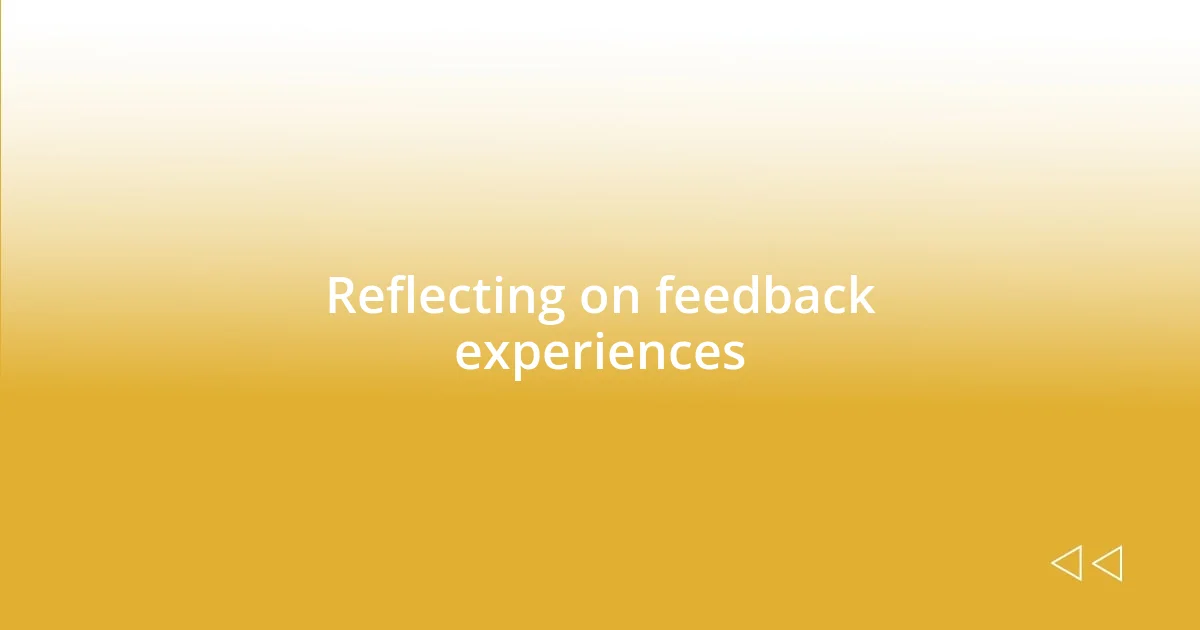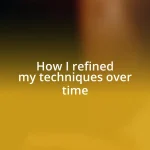Key takeaways:
- Engaging with peer feedback cultivates collaboration and personal growth by offering new perspectives and insights.
- Effective feedback requires preparation, including reviewing work thoroughly, framing comments positively, and using specific, actionable language.
- Transformative feedback experiences involve reflection on emotional responses, engaging in open discussions, and applying insights to foster continuous improvement.

Understanding peer feedback importance
Peer feedback holds an invaluable place in our learning journeys, often serving as a mirror reflecting our strengths and areas for improvement. I remember a group project during my college days; when my peers shared their insights, it felt like opening a window to new perspectives I hadn’t considered. It’s not just about getting critique—it’s about fostering growth through shared understanding, which can be both exciting and intimidating.
When I reflect on the moments I received constructive feedback, I often think about the vulnerability it demands. Did I take it well? At first, the sting of criticism was hard to swallow. But as I developed a thick skin, I discovered that each piece of feedback offered a unique lens on my work. Isn’t it fascinating how a simple comment can shift your understanding and drive you to improve in ways you never thought possible?
Engaging with peer feedback is more than just a requirement; it’s an opportunity to cultivate collaboration and connection. I recall a time when a peer’s suggestion transformed my approach to a project, leading to a result I was incredibly proud of. Have you ever experienced that moment when someone else’s insight illuminated a path you couldn’t see before? That’s the magic of peer feedback—it empowers us and drives us forward together.

Preparing to give feedback
Preparing to provide feedback can feel a bit daunting at first. I remember when I was getting ready to give feedback on a classmate’s project. My heart raced as I thought about how my words could impact their confidence. I learned that setting an open and supportive tone beforehand can make a world of difference. It not only eases my nerves but also encourages a more receptive atmosphere for the recipient.
Here are some steps to enhance your preparation:
- Review the work thoroughly: Take the time to understand the project fully before diving into feedback.
- Identify key points: Jot down specific aspects that resonate with you—both strengths and areas for improvement.
- Practice active listening: Be ready to engage in a dialogue, making sure to capture their perspective as well.
- Frame your feedback positively: Think about how to communicate your thoughts in a constructive and encouraging manner.
- Use “I” statements: This makes your feedback more personal and less confrontational, allowing for a more meaningful exchange.
Focusing on these elements not only calms my nerves but also helps me approach giving feedback as a collaboration rather than a critique.

Techniques for effective feedback
When it comes to providing effective feedback, I’ve found that genuine intention matters most. Many times, I’ve experienced the difference that comes from sharing my thoughts with genuine concern for my peer’s growth. For example, there was a time when I offered constructive criticism to a friend who was struggling with a presentation. Instead of focusing solely on what needed fixing, I highlighted her strengths first, which instantly put her at ease.
Another technique that I swear by is being specific. Vague comments often leave the receiver feeling lost, don’t you think? I remember critiquing a colleague’s report and making sure to point out particular sections that were exceptionally well-written, followed by areas where clarity was lacking. This way, my feedback became a roadmap for improvement—something they could tangibly work on. Few things are as fulfilling as seeing improvement in someone else’s work as a result of my feedback.
Lastly, timing plays a crucial role in how feedback is received. In my experience, delivering feedback soon after an event—like a presentation—helps convey genuine observations while they’re still fresh. I once waited too long to provide my thoughts on a project, thinking it would allow for more reflection. Instead, my feedback felt disconnected. By sharing insights promptly, I’ve often noticed a positive shift in the dialogue, allowing for more meaningful exchanges.
| Technique | Description |
|---|---|
| Genuine Intention | Focus on the growth and well-being of the peer, highlighting their strengths first. |
| Specificity | Provide precise, actionable feedback rather than generalized comments. |
| Timing | Deliver feedback promptly after an event to keep it relevant and impactful. |

Receiving feedback constructively
Receiving feedback constructively can be a transformative experience if approached with an open mind. I still remember a time when I received feedback on my writing. At first, I felt defensive, thinking my skills were being questioned. However, once I took a deep breath and reminded myself that the feedback was meant to help me grow, I found clarity. It’s essential to shift away from personal feelings and focus on the intent behind the feedback. Isn’t it amazing how a simple mindset change can lead to significant improvement?
I’ve learned that actively engaging with feedback is just as vital as receiving it. For instance, after a peer reviewed a project I was deeply passionate about, I initiated a follow-up conversation. I asked them to elaborate on their points, particularly where I could improve. Their insights reshaped my approach completely, and it’s refreshing to realize that dialogue can elevate our understanding. Have you ever had a conversation that turned your perspective around? For me, these moments highlight the collaborative nature of feedback.
One crucial aspect of receiving feedback is to practice patience with oneself. After getting critiques, it’s easy to feel overwhelmed. I recall a time when a group project didn’t go as planned, and I was inundated with feedback. Instead of letting it cloud my judgment, I took a day to process it all calmly. I made notes on what resonated most and started seeing patterns in the suggestions. This reflective time not only allowed me to sort through the feedback, but it also fostered a deeper appreciation for the diverse perspectives others brought to the table. Emotional digestion of feedback can be your secret weapon—it’s vital for meaningful growth.

Engaging in feedback discussions
Engaging in feedback discussions can feel a bit daunting, but I always remind myself that these conversations are about growth, not criticism. There was a time when I sat down with a colleague to discuss her project. Initially, I could sense her anxiety, but when we dove into the details together, our conversation shifted to a collaborative brainstorming session. I truly believe that creating a friendly atmosphere can pave the way for open dialogue— how often do you find that when the pressure is off, the best ideas flow?
I also make it a point to ask open-ended questions during feedback discussions. Instead of simply stating what I thought didn’t work, I remember asking a teammate, “What do you think about this approach?” This not only encouraged her to share her thoughts but also made her feel valued. The conversation took on a life of its own, leading us to discover innovative solutions we hadn’t considered before. Isn’t it incredible how a simple question can unlock new perspectives?
Lastly, I’ve found that reflecting on feedback during our discussions can make a huge difference. For instance, while reviewing a peer’s project, I asked if they could share their thought process. This small shift helped me understand their vision better, and ultimately, it allowed me to provide more tailored suggestions. It’s like peeling back layers; I think engaging this way brings a level of depth that mere surface feedback can’t achieve. How richly do your discussions unfold when you delve into the ‘why’ behind the work?

Implementing feedback for improvement
Implementing feedback for improvement requires a proactive approach. I vividly remember a time when I encountered some tough criticism on a design project. Instead of sulking, I decided to revisit the suggestions with a cup of coffee in hand. As I sifted through the comments, I started marking areas that resonated with me. It was during this reflective process that I realized how powerful it can be to look at feedback as a list of opportunities rather than a list of shortcomings. Have you experienced that shift in perspective before?
When it comes to applying feedback, I’ve found it useful to break suggestions down into actionable steps. After receiving feedback on a presentation, I crafted a to-do list that included revising key slides and practicing my delivery more deliberately. Surprisingly, tackling these small steps one at a time made the changes feel less overwhelming. In my experience, this method not only enhances the quality of my work but also builds my confidence. Can you recall a time when taking small steps led to a big transformation for you?
I also make it a habit to track my progress after implementing feedback. For instance, I keep a journal that documents not only the feedback I received but also how I applied it and the results that followed. This retrospective insight has proven to be incredibly valuable. It’s fascinating to see patterns in my growth and realize that constructive criticism can lead to tangible development. Isn’t it rewarding to witness your evolution in real-time, backed by the lessons learned from feedback?

Reflecting on feedback experiences
Reflecting on feedback experiences can be quite enlightening. I recall a moment after a particularly intense project review when I sat quietly with my notes, contemplating not just what was said, but how it made me feel. The initial sting of criticism was quickly replaced with a realization that each piece of feedback was a stepping stone toward improvement. Have you ever let a moment of vulnerability lead you to clarity?
As I look back on various feedback encounters, I notice a common thread: the emotional response connected to receiving feedback can shape how I act on it. I once received a comment from a mentor that made me question my approach entirely, and I had to wrestle with some self-doubt before I could see the value in their words. This introspection led me to appreciate the constructive aspects of feedback even amid discomfort. Why do we often hesitate to embrace the growth that comes through challenge?
In another instance, I found journaling about feedback helped me uncover patterns in my reactions over time. After each critical discussion, I would jot down my thoughts, including the positive shifts that followed. This practice transformed my feedback experiences from isolated events into a rich tapestry of growth and resilience. Isn’t it fascinating how looking back can illuminate the path forward?















